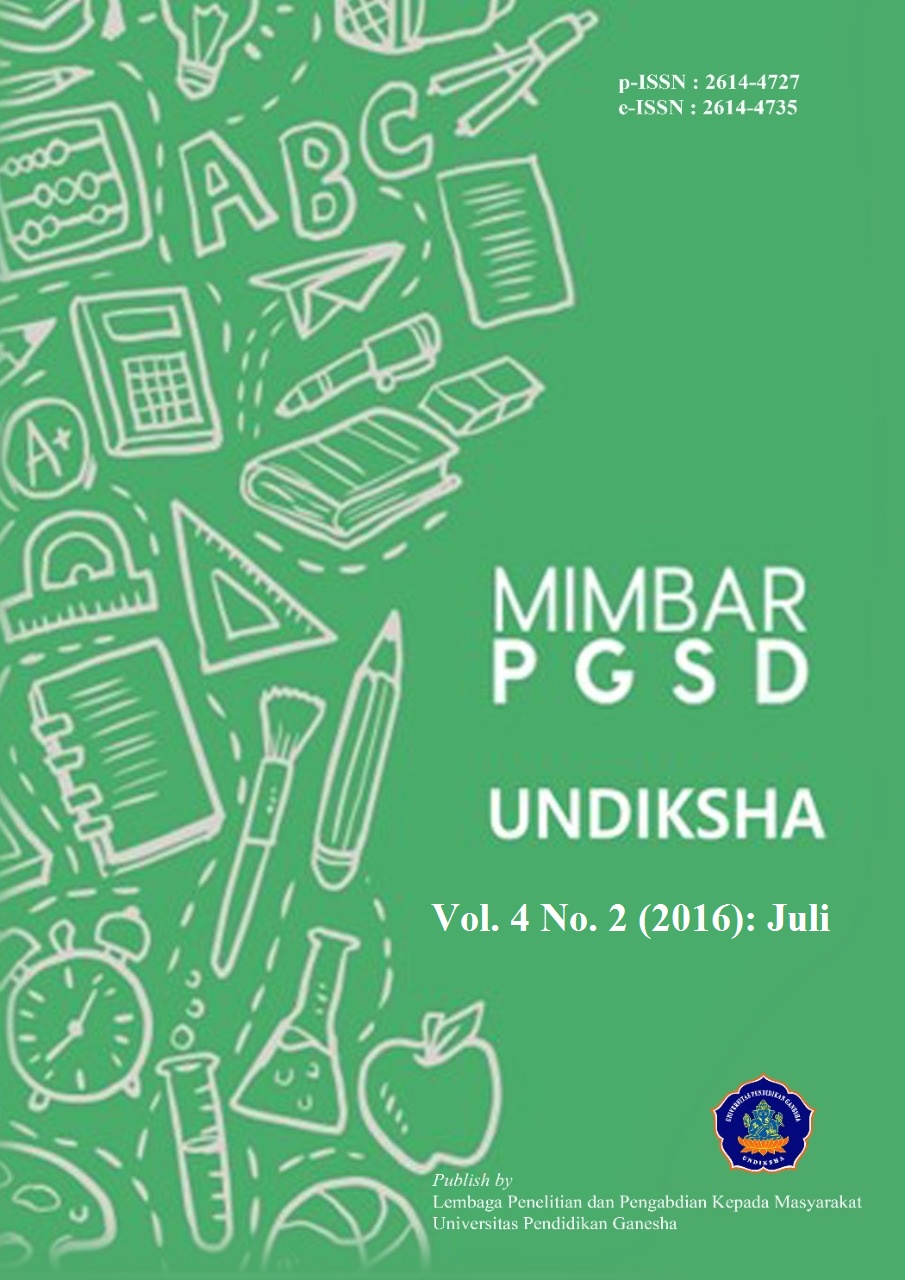ANALISIS GAYA BELAJAR BAHASA INDONESIA TERHADAP HASIL BELAJAR SISWA DI SD GUGUS VI KECAMATAN BULELENG
DOI:
https://doi.org/10.23887/jjpgsd.v4i2.7675Abstract
Penelitian ini merupakan penelitian deskriptif yang bertujuan untuk mengetahui: (1) gaya belajar dalam pembelajaran bahasa Indonesia dan (2) dampak gaya belajar terhadap hasil belajar bahasa Indonesia pada siswa kelas IV di SD Gugus VI Kecamatan Buleleng Tahun 2015/2016. Populasi penelitian ini adalah siswa kelas IV pada SD Gugus VI kecamatan Buleleng dan sampel penelitian ini adalah siswa kelas IV semester genap di SD Negeri 2 Kampung Baru, SD Negeri 3 Kampung Baru, dan SD Negeri 7 Kampung Baru. Metode pengumpulan data yang digunakan adalah kuesioner dan dokumentasi. Hasil penelitian kecenderungan gaya belajar ini menunjukkan bahwa (1) Deskripsi kecenderungan gaya belajar visual dengan jumlah responden 41 dengan persentase 63,07%, kecenderungan gaya belajar auditorial dengan jumlah responden 11 dengan persentase 16,93%, dan kecenderungan gaya belajar kinestetik dengan jumlah responden 13 dengan persentase 20,00 %. Hasil penelitian dampak gaya belajar terhadap hasil belajar menunjukkan bahwa (2) Deskripsi hasil belajar dengan gaya belajar visual masuk ke dalam kategori sangat baik dengan rata-rata 77 (skor maksimal 100), gaya belajar auditorial masuk ke dalam kategori baik dengan rata-rata 74 (skor maksimal 100), dan gaya belajar kinestetik masuk ke dalam kategori baik dengan rata-rata 75 (skor maksimal 100). Dengan demikian gaya belajar yang di terapkan di kelas IV lebih cenderung ke dalam gaya belajar visual dengan jumlah responden sebanyak 41 dan memperoleh hasil belajar dengan kategori sangat tinggi yaitu dengan rata-rata 77Kata Kunci : Gaya Belajar, Hasil Belajar Bahasa Indonesia.
This research is a descriptive study that aims to identify: 1 learning styles in learning Indonesian and (2) the impact of learning styles on learning outcomes Indonesian in the fourth grade students in elementary Cluster VI District of Buleleng Year 2015/2016. The study population was the fourth grade students in elementary Cluster VI Buleleng districts and sample of this research is the fourth grade students in the second semester of SD Negeri 2 Kampung Baru, Kampung Baru SD Negeri 3, and SD Negeri 7 Kampung Baru. The method used to collect data for this study were questionnaires and documentation. Data analysis techniques used in this research is descriptive analysis technique that is performed to test the low score of the questionnaire that was disis respondents. Descriptive analyzes conducted on the average value of the mean, median and mode. the tendency of visual learning style with the number of respondents 41 with the percentage 63.07%, the tendency of auditory learning styles with the number of respondents 11 and the percentage of 16.93%, and the tendency of kinesthetic learning style with the number of respondents 13 with the percentage 20.00%. The results of the impact study learning styles on learning results show that (2) Description of learning outcomes with a visual learning style into the excellent category with an average of 77 (the maximum score of 100), learning styles auditory fit into either category with an average of 74 (maximum score of 100), and kinesthetic learning style fit into either category with an average of 75 (the maximum score of 100). Thus style of learning is applied in the fourth grade are more likely into the visual learning style by the number of respondents was 41 and obtained the learning outcomes by category is as high as the average of 77.
keyword : Learning Styles, Learning Outcomes Indonesian.
Published
2016-07-20
How to Cite
., K. A. P., ., D. N. W. A., & ., I. W. W. S. M. (2016). ANALISIS GAYA BELAJAR BAHASA INDONESIA TERHADAP HASIL BELAJAR SISWA DI SD GUGUS VI KECAMATAN BULELENG . MIMBAR PGSD Undiksha, 4(2). https://doi.org/10.23887/jjpgsd.v4i2.7675
Issue
Section
Articles
License
Authors who publish with the Mimbar PGSD Undiksha agree to the following terms:
- Authors retain copyright and grant the journal the right of first publication with the work simultaneously licensed under a Creative Commons Attribution License (CC BY-SA 4.0) that allows others to share the work with an acknowledgment of the work's authorship and initial publication in this journal.
- Authors are able to enter into separate, additional contractual arrangements for the non-exclusive distribution of the journal's published version of the work (e.g., post it to an institutional repository or publish it in a book), with an acknowledgment of its initial publication in this journal.
- Authors are permitted and encouraged to post their work online (e.g., in institutional repositories or on their website) prior to and during the submission process, as it can lead to productive exchanges, as well as earlier and greater citation of published work. (See The Effect of Open Access)















